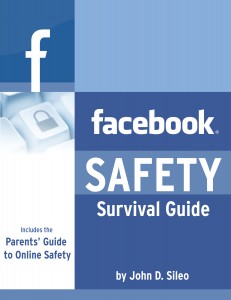Facebook Safety: 7 Deadly Data Mistakes
Facebook Safety will make headlines in 2011, as it will be the year when identity theft, data breach, cyber stalking and cyber-bullying will move heavily into social networking. Social networking is the perfect platform for these crimes, as it aggregates vast quantities of your sensitive personal information that a social engineer (con artist), corporate spy, identity thief, stalker or regular old burglar needs to take advantage of you. It’s a one-stop data shop. As I speak around the country on information survival, I hear a lot of first-hand accounts of how people have been taken advantage of using their Facebook profile (among other social networking sites, but Facebook is definitely the big winner). Here are the Top 7 Deadly Facebook Data Mistakes (in no particular order, and unfortunately the list is not even close to exhaustive) that I address in my workbook, The Facebook Safety Survival Guide:
- Setting up a weak password to get into your Facebook account, making account takeover an easy and attractive proposition for hackers. Not only does account takeover allow criminals to run Friends in Distress scams on your contact list, it also allows them to conduct illegal activity as you (generally child pornography or, ironically, the sale of stolen identities), so that you are liable for their crimes (unless you can prove otherwise).
- Sharing too much personal identity information when you set up your initial profile (e.g., full name, birth date and hometown – small pieces of data that when added together, give a thief every thing he needs to determine your Social Security number and control your credit profile).
- Failing to customize your privacy settings. This mistake could have a top 20 list all of it’s own, as it is such a significant risk if you do nothing. For example, if you take the default privacy settings in Facebook (most users do this without thinking), you are: allowing everyone in the network to see all of your wall posts and a great deal of personal profile information; allowing applications to access, aggregate and sell your data; giving outsiders access to your private photo and video albums; allowing your contacts and networks to share your information (unknowingly) with outside users, vendors, and non-friends; allowing others to publish your current location in Places (even if you aren’t there) and allowing Facebook to copy, store, print and utilize your data footprint in any way they see fit.
- Posting travel plans or location data allows thieves to know exactly when to rob you, unhealthy ex-spouses where to stalk you and law enforcement how to deliver your subpoena.
- Accepting friend requests from people that aren’t actually friends, extending your network to a group of people who could potentially take advantage of you or your contacts. If you don’t know them in person, don’t befriend them digitally.
- Posting photos or videos that put your children, friends or self at risk. 99% of Facebook users are there for the right reasons – to connect in a healthy way. Unfortunately, the other 1% are made up of pedophiles, stalkers, burglars, identity thieves and sick individuals who use photos and videos in your albums to identify you in person. Don’t even get me started on all of the disheartening stories I hear on this topic.
- Failing to monitor your child’s online presence for bullying, inappropriate content, conversations or contact. In my experience, an uninvolved parent ends up being a sorry parent.
Don’t fall prey to the 7 Deadly Mistakes (and there are many more). Take steps before it is too late to protect yourself, your family, your business and your reputation. For more information, learn more about The Facebook Safety Survival Guide.
 John Sileo is an information survival expert whose clients include the Department of Defense, Pfizer, Homeland Security, FDIC, FTC, Federal Reserve Bank, Blue Cross Blue Shield and hundreds of corporations and organizations of all sizes. He earns his keep delivering highly motivational identity theft speeches.
John Sileo is an information survival expert whose clients include the Department of Defense, Pfizer, Homeland Security, FDIC, FTC, Federal Reserve Bank, Blue Cross Blue Shield and hundreds of corporations and organizations of all sizes. He earns his keep delivering highly motivational identity theft speeches.
The Facebook Safety Survival Guide gives you extensive background knowledge on many of the safety and privacy issues that plague social networking sites, inlcuding Facebook, LinkedIn, Twitter, MySpace, etc. Social networking, texting, instant messaging, video messaging, blogging – these are all amazing tools that the American workforce uses natively, as part of their everyday lives. This Guide’s purpose is to make their online vigilance and discretion just as native, so that they learn to protect the personal information they put on the web before it becomes a problem. Social networking is immensely powerful and is here for the long run, but we must learn to harness and control it.
Sorry, comments for this entry are closed at this time.









1 Trackbacks/Pingbacks